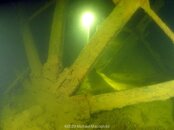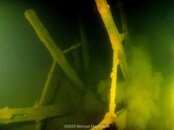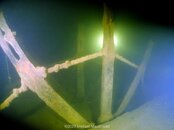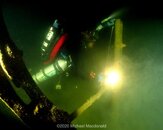Just when you think everything has already been found in Lake Champlain she continues to give up more fascinating pieces of history.
The Phoenix was an early sidewheel paddle steamer that was built in 1815 by Lake Champlain Steam-boat Company at its shipyard in Vergennes, Vermont. She was the second steamer to sail on Lake Champlain, after the Vermont (launched in 1808), which is said to be the first regularly operated steamship anywhere in the world. The Phoenix’s arrival in Lake Champlain continued to signal a new age of travel and helped usher in the dawn of the early steamship era. Steamships had only just been invented in 1807, a mere 8 years after the launch of the Phoenix.
On September 4, 1819, The Phoenix caught fire after departing Burlington. While most of the passengers and crew were able to safely escape six people perished. The ship grounded on Colchester Reef and the hull continued to burn to the waterline. Her charred wreckage (estimated to be approximately 40% complete due to fire and subsequent salvage) is a popular dive in Lake Champlain and is part of the Vermont Underwater Historic Preserve operated by the Lake Champlain Maritime Museum. She is considered the oldest surviving example of a sidewheel steamer in the world and is also listed in the National Register of Historic Places.
My friend Gary Lefebvre accidently stumbled upon these targets while running a sidescan grid pattern looking for another historical wreck and informed the Lake Champlain Maritime Museum of his discovery. Often smaller targets on sidescan can be easily overlooked or misinterpreted as natural or geological so they are missed. Based on the distance from the already known Phoenix wreckage, as well as the evidence of charred and burned wood present on paddlewheels this easily helped confirm that these in fact did belong to the Phoenix.
What is completely astonishing is this discovery comes almost exactly 201 years on the anniversary of the Phoenix’s ill-fated disaster. Nobody knew that these paddlewheels had survived the fire that burned her hull to the waterline until they were found in 190’ and 180’ of water approximately 100 yards apart. Furthermore, the location of these paddlewheels also helps estimate the final course the Phoenix took before her sinking opening up the possibility of a debris field where other artifacts or wreckage could potentially be found.
My friend John and I were lucky enough to dive these yesterday after Gary had confirmed the location with his ROV. We were able to take some measurements as well as pictures and video on our dives. These are small targets on a very thick silty bottom which makes photography extremely difficult. The visibility was approximately 10ft at 180-190ft however this quickly diminished to almost nothing after only swimming around the wreckage a few times no matter how careful our fin kicks are. Both paddlewheels sit in a bowl-type depression on a slope which puts your fins almost at equal level to the thick silty bottom. We had two great dives and accomplished our objective to take measurements and video. I am looking forward to returning here in the future to explore the surrounding area.
Press Release:
Paddlewheels Of Steamboat Phoenix Discovered In Lake Champlain | Agency of Commerce and Community Development
New Articles
Steamboat Phoenix: Paddlewheels found in Champlain after 201 years
Steamboat Phoenix paddle wheels found 201 years later - CNN
Paddle-wheels from “Phoenix” found in Lake Champlain | Local 22/44 News






The Phoenix was an early sidewheel paddle steamer that was built in 1815 by Lake Champlain Steam-boat Company at its shipyard in Vergennes, Vermont. She was the second steamer to sail on Lake Champlain, after the Vermont (launched in 1808), which is said to be the first regularly operated steamship anywhere in the world. The Phoenix’s arrival in Lake Champlain continued to signal a new age of travel and helped usher in the dawn of the early steamship era. Steamships had only just been invented in 1807, a mere 8 years after the launch of the Phoenix.
On September 4, 1819, The Phoenix caught fire after departing Burlington. While most of the passengers and crew were able to safely escape six people perished. The ship grounded on Colchester Reef and the hull continued to burn to the waterline. Her charred wreckage (estimated to be approximately 40% complete due to fire and subsequent salvage) is a popular dive in Lake Champlain and is part of the Vermont Underwater Historic Preserve operated by the Lake Champlain Maritime Museum. She is considered the oldest surviving example of a sidewheel steamer in the world and is also listed in the National Register of Historic Places.
My friend Gary Lefebvre accidently stumbled upon these targets while running a sidescan grid pattern looking for another historical wreck and informed the Lake Champlain Maritime Museum of his discovery. Often smaller targets on sidescan can be easily overlooked or misinterpreted as natural or geological so they are missed. Based on the distance from the already known Phoenix wreckage, as well as the evidence of charred and burned wood present on paddlewheels this easily helped confirm that these in fact did belong to the Phoenix.
What is completely astonishing is this discovery comes almost exactly 201 years on the anniversary of the Phoenix’s ill-fated disaster. Nobody knew that these paddlewheels had survived the fire that burned her hull to the waterline until they were found in 190’ and 180’ of water approximately 100 yards apart. Furthermore, the location of these paddlewheels also helps estimate the final course the Phoenix took before her sinking opening up the possibility of a debris field where other artifacts or wreckage could potentially be found.
My friend John and I were lucky enough to dive these yesterday after Gary had confirmed the location with his ROV. We were able to take some measurements as well as pictures and video on our dives. These are small targets on a very thick silty bottom which makes photography extremely difficult. The visibility was approximately 10ft at 180-190ft however this quickly diminished to almost nothing after only swimming around the wreckage a few times no matter how careful our fin kicks are. Both paddlewheels sit in a bowl-type depression on a slope which puts your fins almost at equal level to the thick silty bottom. We had two great dives and accomplished our objective to take measurements and video. I am looking forward to returning here in the future to explore the surrounding area.
Press Release:
Paddlewheels Of Steamboat Phoenix Discovered In Lake Champlain | Agency of Commerce and Community Development
New Articles
Steamboat Phoenix: Paddlewheels found in Champlain after 201 years
Steamboat Phoenix paddle wheels found 201 years later - CNN
Paddle-wheels from “Phoenix” found in Lake Champlain | Local 22/44 News









